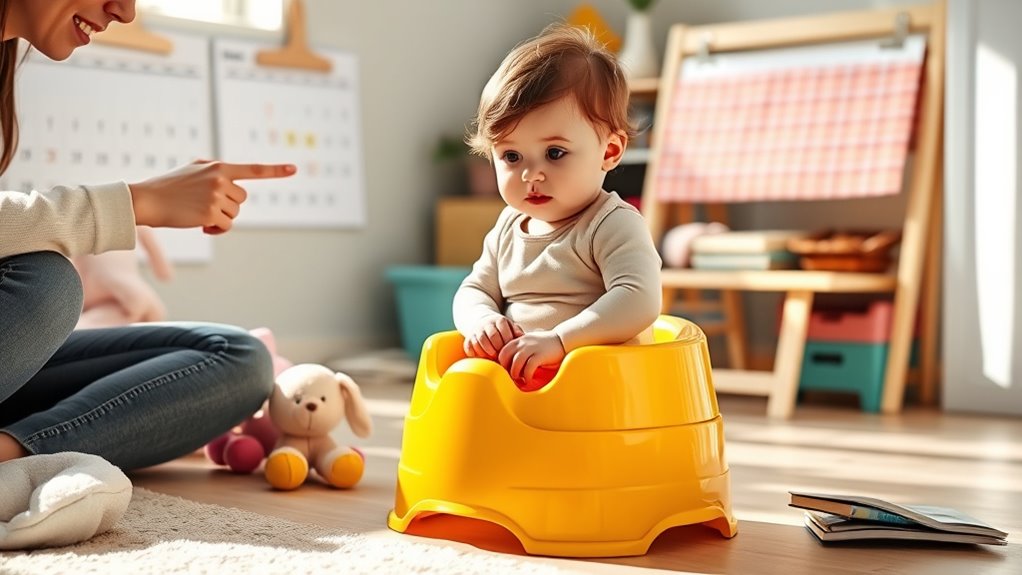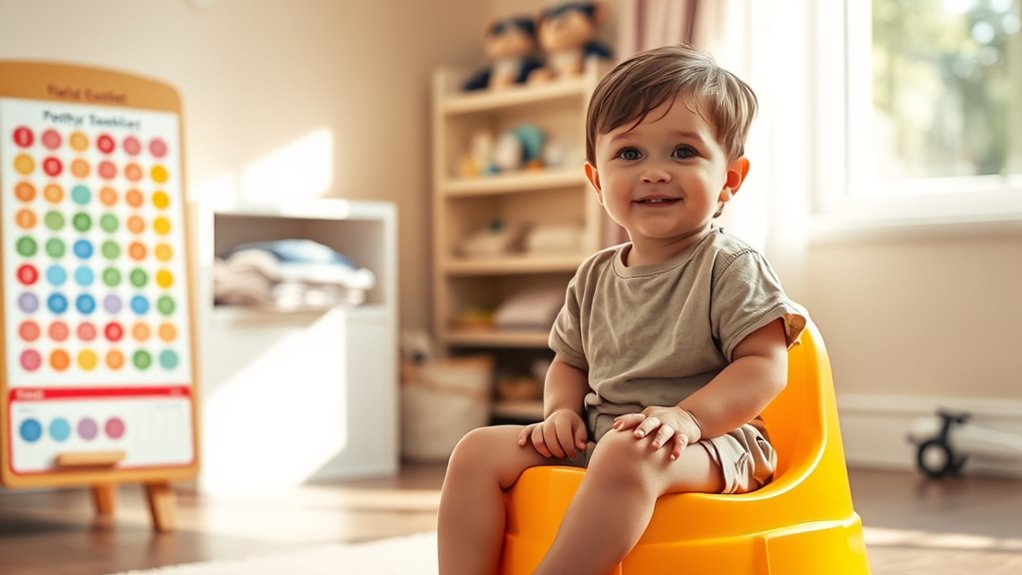To tell if your child is ready for potty training, watch for signs like staying dry longer, showing interest in bathroom activities, and expressing discomfort with diapers. Use positive routines, keep supplies accessible, and be patient as progress varies. Most kids are ready between ages 2-3, but it can take months. Staying consistent and supportive helps build confidence. Keep exploring to learn more about effectively guiding your child’s journey to independence.
Key Takeaways
- Look for physical signs like staying dry longer and showing interest in bathroom activities.
- Use consistent routines and positive reinforcement to support potty training efforts.
- Recognize typical age ranges: daytime independence between 2-3 years, nighttime dryness after 4.
- Observe emotional cues such as curiosity or discomfort with diapers indicating readiness.
- Understand that individual timelines vary; patience and gradual progress are essential for success.
Recognizing Physical and Emotional Signs of Readiness

Understanding when your child is ready for potty training involves paying attention to both physical and emotional cues. One key physical sign is observing their bedwetting patterns. If your child consistently stays dry for longer periods or wakes up dry after naps, it indicates their bladder control is developing. Emotional cues are equally important; look for signs like showing interest in the bathroom, wanting to wear underwear, or telling you when they’ve gone in their diaper. They might also display discomfort with dirty diapers or express curiosity about potty use. Recognizing these signals helps gauge readiness and suggests they’re mentally prepared to start potty training. Being attuned to these physical and emotional cues helps you determine the right time to begin, making the process smoother for both of you.
Effective Strategies to Support Your Child’s Potty Training Journey

To support your child’s potty training journey effectively, establishing a consistent routine is essential. This helps your child understand expectations and build confidence. Be aware of common setbacks, like accidents or resistance, which often stem from misconceptions—potty training myths that suggest it’s quick or that punishment is effective. Instead, stay patient and encouraging. Use positive reinforcement, such as praise or small rewards, to motivate your child. Keep supplies accessible and create a designated potty spot to foster familiarity. Remember, setbacks are normal; they’re part of the learning process. Avoid rushing or pressuring your child, and focus on offering gentle guidance. Consistency, patience, and understanding will help overcome challenges and support a successful potty training experience.
Typical Timelines and Expectations for Successful Potty Training

Every child’s potty training journey unfolds at its own pace, but knowing what to expect can help set realistic goals. Typically, most children achieve diaper independence between 2 and 3 years old, though some may take longer. Nighttime dryness often lags behind daytime control, with many children not staying dry overnight until age 4 or later.
Every child’s potty training journey varies; patience and support are essential.
Consider these timelines:
- Complete daytime potty training usually takes 3 to 6 months of consistent effort.
- Nighttime dryness may develop gradually over the next year or more.
- Every child progresses differently, so patience and support are key.
Stay flexible and celebrate small victories along the way, understanding that delays don’t mean failure—just a part of your child’s unique development.
Frequently Asked Questions
How Do I Handle Setbacks During Potty Training?
When setbacks happen during potty training, stay patient and calm. Handle accidents without punishment, offering reassurance and gentle guidance. Remember, setbacks are normal, so give your child time to adjust. Maintain consistent routines and encourage your child’s efforts. Using potty training patience helps build confidence, and handling accidents with understanding makes the process smoother. Keep a positive attitude, and celebrate small successes to motivate your child.
When Should I Switch From Diapers to Underwear?
Think of switching from diapers to underwear as planting a seed. When your child reaches age milestones like staying dry for several hours and showing interest, it’s time to change. Use positive training techniques, celebrating small successes. This progression usually happens around 2-3 years old. Trust your child’s cues, and remember, patience helps the bloom of confidence and independence to flourish.
What Are Common Signs of Resistance to Potty Training?
You might notice resistance to potty training if your child refuses to sit on the potty, shows tantrums, or avoids the process altogether. Don’t fall for potty training myths that suggest forcing works; instead, explore different training techniques like gradual introduction or positive reinforcement. If your kid resists, give them time and patience. Understanding their cues helps you tailor approaches, making potty training smoother and less stressful for both of you.
How Can I Motivate My Reluctant Child?
Think of potty training as opening a treasure chest—you’re the key! To motivate your reluctant child, show patience and celebrate small wins. Remember, potty training myths often lead parents to expect too much too soon; age expectations vary. Keep the process fun and encouraging, offering praise and rewards. Your child will see potty time as a victory, making them enthusiastic to explore this new milestone with confidence and joy.
Should I Use Rewards or Consequences?
You should use reward systems to motivate your reluctant child, as positive reinforcement encourages progress. When they succeed, praise or small rewards can boost their confidence. Consequence strategies, like gentle reminders or natural consequences, can also help, but avoid harsh punishments. Combining reward systems with consistent, calm consequence strategies creates a supportive environment that builds motivation and helps your child feel empowered during potty training.
Conclusion
Remember, every child is unique and will conquer potty training when they’re truly ready. Watch for signs, stay patient, and use supportive strategies—you’re guiding them toward independence that’s as big as the sky. With consistent patience, your child’s progress will come faster than you ever imagined, turning what feels like an Everest into a smooth, manageable climb. Trust the process, celebrate small victories, and soon, potty training will be just another milestone you’ve conquered together.









